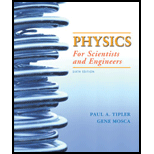
Concept explainers
(a)
The charge on the sphere.
(a)
Explanation of Solution
Given:
The radius of the microsphere is
The Magnitude of electric field is
The magnitude of the drag force is
The viscosity of the air is
The density of the polystyrene is
Formula used:
Write the expression for the downward and upward force.
Here,
Write the expression for the force.
Here,
Write the expression for the mass.
Here,
Substitute
Write the expression for the charge.
Here,
Write the expression for the volume of the sphere.
Here,
Substitute
Solve the above equation for
Calculation:
Substitute
Conclusion:
Thus, the charge on the sphere is
(b)
The number of excess electron on the sphere.
(b)
Explanation of Solution
Given:
The radius of the microsphere is
The Magnitude of electric field is
The magnitude of the drag force is
The viscosity of the air is
The density of the polystyrene is
Formula used:
Write the expression for the downward and upward force.
Here,
Write the expression for the force.
Here,
Write the expression for the mass.
Here,
Substitute
Write the expression for the charge.
Here,
Write the expression for the volume of the sphere.
Here,
Substitute
Solve the above equation for
Calculation:
Substitute
Conclusion:
Thus, the number of excess electron on the sphere is 3.
(c)
The new terminal speed.
(c)
Explanation of Solution
Given:
The radius of the microsphere is
The Magnitude of electric field is
The magnitude of the drag force is
The viscosity of the air is
The density of the polystyrene is
Formula used:
Write the expression for the forces when electric field is upward.
Here,
Write the expression for the force.
Here,
Write the expression for the mass.
Here,
Substitute
Solve the above equation for
Calculation:
Substitute
Conclusion:
Thus, the new terminal speed is
Want to see more full solutions like this?
Chapter 21 Solutions
Physics For Scientists And Engineers
- A point charge of 4.00 nC is located at (0, 1.00) m. What is the x component of the electric field due to the point charge at (4.00, 2.00) m? (a) 1.15 N/C (b) 0.864 N/C (c) 1.44 N/C (d) 1.15 N/C (e) 0.864 N/Carrow_forwardA 1.75-nC charged particle located at the origin is separated by a distance of 0.0825 m from a 2.88-nC charged particle located farther along the positive x axis. If the 1.75-nC particle is kept fixed at the origin, where along the positive x axis should the 2.88-nC particle be located so that the magnitude of the electrostatic force it experiences is twice as great as it was in Problem 27?arrow_forwardIn nuclear fission, a nucleus of uranium-238, which contains 92 protons, can divide into two smaller spheres, each having 46 protons and a radius of 5.90 1015 m. What is the magnitude of the repulsive electric force pushing the two spheres apart?arrow_forward
- A circular ring of charge with radius b has total charge q uniformly distributed around it. What is the magnitude of the electric field at the center of the ring? (a) 0 (b) keq/b2 (c) keq2/b2 (d) keq2/b (e) none of those answersarrow_forwardA particle with charge q on the negative x axis and a second particle with charge 2q on the positive x axis are each a distance d from the origin. Where should a third particle with charge 3q be placed so that the magnitude of the electric field at the origin is zero?arrow_forwardA circular ring of charge of radius b has a total charge q uniformly distributed around it. Find the magnitude of the electric field in the center of the ring. (a) 0 (b) keq/b2 (c) keq2/b2 (d) keq2/b (e) None of these answers is correct.arrow_forward
- Is it possible for a conducting sphere of radius 0.10 m to hold a charge of 4.0 C in air? The minimum field required to break down air and turn it into a conductor is 3.0 106 N/C.arrow_forwardaA plastic rod of length = 24.0 cm is uniformly charged with a total charge of +12.0 C. The rod is formed into a semicircle with its center at the origin of the xy plane (Fig. P24.34). What are the magnitude and direction of the electric field at the origin? Figure P24.34arrow_forwardThree charged particles are located at the corners of an equilateral triangle as shown in Figure P19.9. Calculate the total electric force on the 7.00-C charge.arrow_forward
- What is the magnitude of the electric field due to a charged particle at its exact location (r = 0)?arrow_forwardAn electron and a proton, each starting from rest, are accelerated by the same uniform electric field of 200 N/C. Determine the distance and time for each particle to acquire a kinetic energy of 3.21016 J.arrow_forwardA Figure P23.65 shows two identical conducting spheres, each with charge q, suspended from light strings of length L. If the equilibrium angle the strings make with the vertical is , what is the mass m of the spheres? Figure P23.65arrow_forward
 Physics for Scientists and Engineers: Foundations...PhysicsISBN:9781133939146Author:Katz, Debora M.Publisher:Cengage Learning
Physics for Scientists and Engineers: Foundations...PhysicsISBN:9781133939146Author:Katz, Debora M.Publisher:Cengage Learning Principles of Physics: A Calculus-Based TextPhysicsISBN:9781133104261Author:Raymond A. Serway, John W. JewettPublisher:Cengage Learning
Principles of Physics: A Calculus-Based TextPhysicsISBN:9781133104261Author:Raymond A. Serway, John W. JewettPublisher:Cengage Learning College PhysicsPhysicsISBN:9781285737027Author:Raymond A. Serway, Chris VuillePublisher:Cengage Learning
College PhysicsPhysicsISBN:9781285737027Author:Raymond A. Serway, Chris VuillePublisher:Cengage Learning College PhysicsPhysicsISBN:9781305952300Author:Raymond A. Serway, Chris VuillePublisher:Cengage Learning
College PhysicsPhysicsISBN:9781305952300Author:Raymond A. Serway, Chris VuillePublisher:Cengage Learning
 Physics for Scientists and Engineers, Technology ...PhysicsISBN:9781305116399Author:Raymond A. Serway, John W. JewettPublisher:Cengage Learning
Physics for Scientists and Engineers, Technology ...PhysicsISBN:9781305116399Author:Raymond A. Serway, John W. JewettPublisher:Cengage Learning





